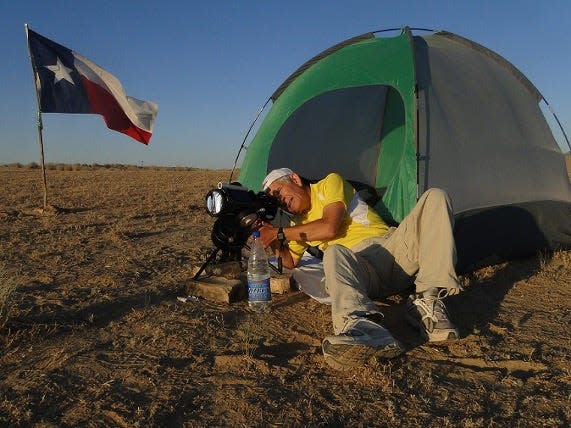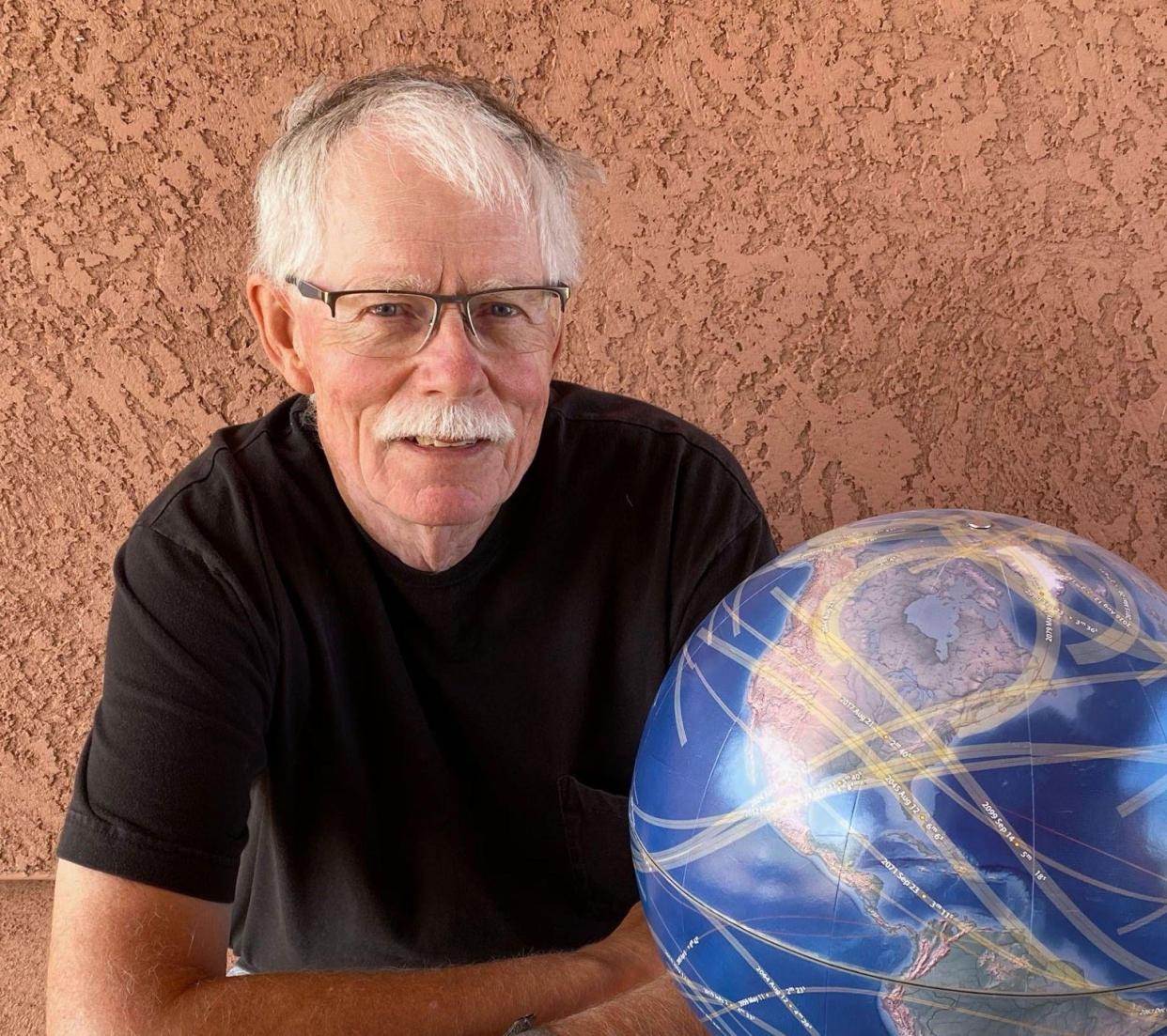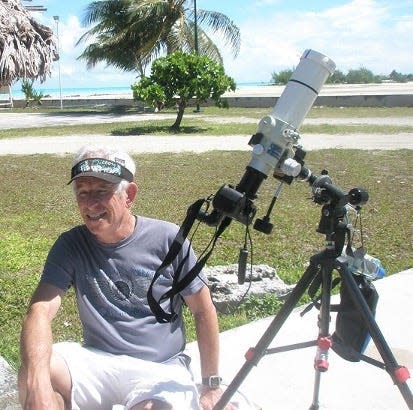For these extreme eclipse chasers, there's one place to be April 8: Mexico
Editor's note: An updated cloud forecast for the April 2024 total solar eclipse is in. Read the latest eclipse forecast and news as of Wednesday, April 3.
Paul Maley grew up in Texas at the height of the Space Age of the 1960s, often looking skyward. He was mesmerized by solar eclipses, including one he photographed as a young teen, its image projected on a lawn chair.
Over the years, an interest in eclipses took him far beyond any Texas backyard.
Today, the 76-year-old is among America’s most prolific eclipse chasers. He has followed them across the globe in 42 countries including Indonesia, Peru, Turkey and Saudi Arabia – taking him to remote villages, sandy deserts and even the icy shores of Antarctica.
On April 8, the retired NASA contractor aims to notch his 84th eclipse – and 30th total eclipse – while floating in the Pacific Ocean on a ship somewhere west of Mazatlan, Mexico.
“I look at every solar eclipse that I can possibly get to,” he said.

For die-hard eclipse chasers, the Holy Grail is a total eclipse – and in the path of totality, this year’s best destination is in central and western Mexico. That’s because the area around Mazatlan, Durango and Torreon provides the likeliest chance of clear skies and the longest period of darkness before the shadow arcs northeast through 13 U.S. states, from Texas to Maine, its shadow sweeping across the land at 1,500 mph.
Maley will be in Mexico helping organize two eclipse trips, one on land and one at sea. They’ll be just some of the eclipse tourists – including dedicated viewers who call themselves umbraphiles, for “shadow lovers” – who have booked hotels, cruise ships or RV trips to Mexico.
Is the April 2024 eclipse safe for pets? Why experts want you to leave them at home.
Fred Espenak, a former NASA astrophysicist who has viewed 30 total eclipses – and who once chased a total eclipse with a path so remote, he had to fly to a landing strip in the Libyan desert so remote it was lit by vehicle headlights – will be with another group in Mazatlan.
Joseph Izen, 67, a retired physics professor, plans to pull a trailer with telescopes and cameras as part of an RV caravan en route to a borrowed ranch north of Durango, Mexico. He said it was the best shot for clear skies that provide an incomparable experience – and an adventure to boot.

He has seen fewer total eclipses than some other chasers but is just as passionate. “As we say in the community, this will be my fourth time in shadow,” he said.
While Maley wouldn’t miss an eclipse himself, total or otherwise, working as a trip coordinator in connection with the Johnson Space Center Astronomical Society means he is able to introduce “newbies” to the profound experience that has driven him around the globe.
In a total eclipse, broad daylight suddenly darkens, temperatures drop, birds quiet and the sun’s corona flickers around a blackened disk, creating an otherworldly atmosphere that can provoke strong reactions.
“I've seen people cry. I've seen them scream. I've seen them run around and just make wild exclamations,” Maley said. “We had one guy that became so overcome, they had to bring him a paper bag ... he was hyperventilating.”
More: What does a total solar eclipse look like? Photos from past events show what to expect in 2024
Fascination fuels shadow chasing
By the late 1960s, around the time of the first lunar landings, Maley landed a job with a company that did contracting work for NASA. He would go on to spend years doing various work including on flight control to support the Apollo missions, Skylab, the space shuttle and the International Space Station.
He kept going to see any eclipse he could, and by 1977 he also began organizing trips in connection with the Johnson Space Center Astronomical Society to help others travel to see them, too.
It became an endless pursuit: Total eclipses cast their shadow at various locations on Earth approximately every 18 months, and chasing them brought adventures around the globe.
In the early 1980s, he traveled to the island of Java, visiting one small town with an Indonesian military police escort. Some residents went inside to avoid looking directly at the sun, he recalled, leaving them largely alone to observe the eclipse.
During the 1990s, his trips took him to Peru, including in the Amazon, to view eclipses. There, he met an American woman who he realized had lived near him back home. Lynn Palmer would later become his wife, and she still travels with him.
He’s also seen people with “New Age” views who sought to “absorb the energy” they connected with eclipses, he said.
In India, he never forgot the indelible image of women standing in the Ganges River with eclipse glasses looking at the sky. In 2010, he journeyed to Uganda to take certain solar measurements at the edge of a path of a total eclipse, instead of the centerline. (He says he’s not among those thrilled only by total eclipses – he finds them all fascinating.)
In 2021, he organized a cruise to Antarctica to view an eclipse, with passengers paying up to $20,000. But cloud cover blocked the view. On top of that, the captain turned back to Argentina early because of bad weather, limiting the number of shore visits. Participants were “noticeably upset,” he recalled, and some blamed him.
“It was bad luck,” he said. “We always tell everyone that regardless of where the eclipse is, there's no way we can guarantee that it will be clear.”

But if eclipses are a reminder of people’s place in a vast universe, weather complications in chasing them – which once included trying to watch an eclipse in Georgia next to a chicken coop in the rain – were also a reminder to him of all that is beyond our human control.
The eclipse-chasing elite
While some veteran eclipse-chasers are solar researchers, others are tour operators, photographers or simply die-hard enthusiasts who chase with their own resources, said Kate Russo, who has written several books on the psychology of eclipse-chasers.
It’s a small community, said Espenak, who formerly worked for NASA on planetary atmosphere modeling and later developed eclipse predictions.
“People who have seen 10 or more total solar eclipses, I doubt there are more than a couple hundred of us,” Espenak said.

Guinness World Records lists the title for the most instances within the moon's umbral shadow, or most total eclipses viewed, at 35, as being held jointly held by two American umbraphiles: Glenn Schneider and John Beattie, whose most recent viewing was on a flight in 2019, according to spokeswoman Kylie Galloway.
Jay Pasachoff, a well-known eclipse-chaser, shared the record before he died two years ago. He had seen more than 70 eclipses, including one in Easter Island, Chile, that he wrote about in an 2010 op-ed in the New York Times. Called “Why I Never Miss a Solar Eclipse,” it described a small community of veteran eclipse chasers reuniting from previous far-flung adventures.
“On this Pacific outpost, 2,200 miles west of the South American coast, hundreds of us have gathered, exchanging warm greetings and catching up on life since we last saw one another – in the Galápagos five years ago, or in Zambia nine years ago, or in Papua New Guinea 16 years ago,” he wrote. “We are umbraphiles: having once stood in the umbra, the Moon’s shadow, during a solar eclipse, we are driven to do so again and again, whenever the Moon moves between the Earth and the Sun.”
The Guinness Book of World Records does not track records on the total number of times people have viewed all types of eclipses, Galloway said. Other types of eclipses includes partial, annular and hybrid.
Maley said he is drawn to see all types of eclipses. On Eclipse Chaser Log, where many but not all chasers self-report their experiences, Maley is listed as being among the top five people for the number of totality views, and having seen the most when all types of eclipses are included. Still more have logged more “time in totality,” meaning they spent more time inside the shadow.
Russo said it’s the experience of totality that drives most chasers. That’s because it provides reactions akin to “primitive fear” and a “sense of wrongness” related to an environment that seems out of line with the normal world.
Veteran chasers describe being hooked by feelings that made their hair stand up on their neck or gave them chills – and has had them coming back for more.
“As soon as that eclipse was over, I realized that this could not be a once-in-a-lifetime event for me, I had to see another one,” Espenak said.
Chasers flock to Mexico
Maley was thrilled to see interest in eclipses skyrocket after the 2017 eclipse that ended a decadeslong drought for the continental United States. NASA estimates that 215 million U.S. adults viewed that eclipse directly or virtually.

“That was a big moment,” he said, one that led many to make years-ahead plans for viewing this year’s eclipse, with some setting their sights on Mexico.
On one Solar Eclipse Chasers Facebook group, one man said recently that he had reserved a place in Mazatlan four years ago.
While the moon’s shadow will first appear 370 miles off the west coast of Mexico, Mazatlan will be the first region of the mainland to experience totality, according to Space.com. The shadow will cross Mexico in 25 minutes, passing Durango, Torreon and Monclova as it heads northeast, crossing the U.S. border at about 1:32 p.m. CT.
In the middle of it will be David Gedalia, a 56-year-old amateur astronomer who has seen three total eclipses and 10 partial ones. The Southern California resident is driving to Concordia, Mexico, in a camper truck in an RV caravan, to ensure safety while traveling through the countryside. He said the cost and time to experience it in person rather than look at photos or video makes the long journey worth it. “It's almost like watching somebody ride a roller coaster on TV, rather than riding a roller coaster yourself.”
Izen, the retired physics professor with a trailer full of telescope gear, will soon be packing up for an overland trip with about 35 RVs organized by the Mexican-based RV touring company Caravanas de Mexico. The group will meet in Nogales and be north of Durango near Ciudad Canatlán on April 8.
Izen saw his first eclipse in 1979 and most recently saw one in Australia, where the jet-lagged enthusiast told an Australian TV reporter, “Seeing totality and seeing my children born – it’s tough to say which is more exciting.”
About 190 miles away, Espenak will be in Mazatlan with a group of about 80 people seeking to mix eclipse watching and a beach trip. He’s preparing a lecture and to be available for questions, he said.
Maley will be offshore with 186 for a 10-day cruise on a small Swan Hellenic cruise ship, at a cost of about $14,000 for a couple in one room. If the clouds roll in, he said, they can try to motor to a clearer location and work with the crew to position the ship for the best viewing.
Being off the coast will provide up to four minutes and 28 seconds of totality, close to the maximum viewing anywhere along the eclipse path. At sea, he said, the sight is just as arresting as it is on land, appearing as if the sun is setting in every direction.
Interest in going to see eclipses may spike after this year’s eclipse, which will pass over more than 31 million residents in the U.S. alone and be the last to be visible in the lower 48 states until 2044.
Maley says he is already planning a series of trips, including going to Egypt in 2027.
And if he makes it to every eclipse between now and 2031, he’ll reach a significant milestone – viewing 100 solar eclipses of different types. That’s if the stars align for him.
But as eclipses have taught him, he can’t control whether that will happen.
This article originally appeared on USA TODAY: Longest solar eclipse will take place over west coast of Mexico
